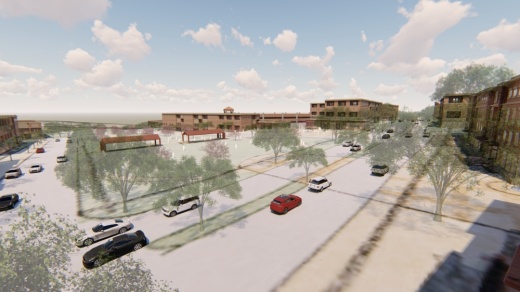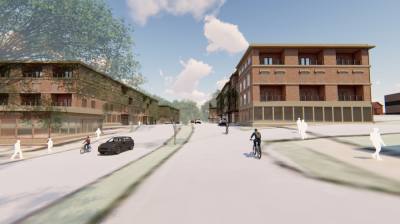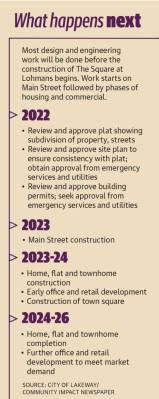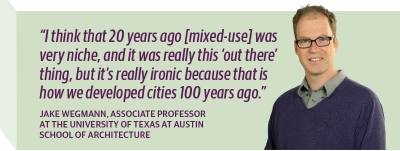In approving zoning Oct. 18 for this planned mixed-use development off Lohmans Crossing and Wingreen Loop, the city of Lakeway is now working with Legend Communities to establish a central gathering place unlike what exists in the city today.
Since 2006, Legend Communities has developed other local communities, such as Rough Hollow and Lakeway Highlands. However, The Square at Lohmans represents a project unlike what the company has attempted in the past, Hayes said.
“We are trying to create this variety of activity and resources that people can enjoy without getting in their vehicles,” Hayes said. “In theory, living in a mixed-use area, someone could live there, go to work, go shopping, get a meal and never get in their car.”
Located on 69 acres west of RM 620, The Square at Lohmans will include a mix of uses, including single-family homes, office space, retail shops, an outdoor amphitheater and green space.
Phased development
The Square at Lohmans envisions a mix of office, retail, rental housing and townhomes around a 2.5-acre green space that also would provide an outdoor amphitheater. The development would also bring 63 single-family houses and the first of two segments needed to extend Main Street past Medical Drive to Lohmans Crossing.
Legend Communities will not build all aspects of the development at once, Hayes said. Based on a commitment made to Lakeway when City Council members approved the zoning for the project, Legend Communities will first build the four lanes of Main Street.
Some housing, including single-family homes up to 4,200 square feet, would likely come next, Hayes said. That would be mixed with construction of some amount of office and commercial spaces. Fully building out these spaces could take from five to 10 years, Hayes said.
“It’s not like 145,000 square feet of commercial shows up on day one,” Hayes said. “That retail and office space happens over years. The residential probably happens a lot quicker because residential is residential, and we know there is a huge scarcity of it.”
Having people living in the development also is critical to attracting retail operators who see customers living within walking distance of a future business location. Hayes said the company aims to balance residential and commercial near the 2.5-acre green space that one day will serve as a town square and amphitheater for public events.
“[We are] figuring out the best way to make that square an active place that is a place that people want to go to,” Hayes said. “If you have the square done, and it’s got an amphitheater and a splash pad, and you’ve got these commercial buildings there, then people get it. Then it becomes this exciting, dynamic idea.”
Mixed-use takes off
The idea of creating mixed-use places such as The Square at Lohmans is not uncommon. Several similar projects are in the works around Central Texas, according to reports from Community Impact Newspaper.
The cities of Bee Cave, Kyle and Leander have multiuse developments in some stage of review or construction. Urban strategist Christopher Leinberger has termed the trend as a shift from drivable suburban areas to “walkable urbanism,” according to online posts he has made to his self-titled website.
Building a blend of housing and commercial spaces in the same development is a throwback to how cities used to be developed, said Jake Wegmann, an associate professor at The University of Texas School of Architecture and a researcher of housing and land use regulation.
“I think that 20 years ago it was very niche, and it was really this ‘out there’ thing, but it’s really ironic because that is how we developed cities 100 years ago,” Wegmann said.
Mixed-use developments, while complicated to plan, fit well with growing suburban cities whose residents want a relatively affordable house that comes with the similar experiences of living in a central downtown area, Wegmann said.
“Urban places feel more enticing because people are around,” he said. “As human beings, we like activity; we kind of like where the action is.”
Multiuse developments also offer the opportunity for long-term planning as developments bring in more varied housing options, the potential for more sales tax revenue, and the potential to reduce traffic if people park their cars once and then walk to various locations, he said.
“If you are thinking for the long term and you are a smaller municipality, you are pretty smart thinking about a place for the long haul,” he said.
Challenges to multiuse concept
In 2013, a mention of a downtown center was made prior to the construction of what is now The Oaks shopping center off RM 620. Some residents of Lakeway in written statements to the city have questioned the success of that development, which a division of Stratus Properties Inc. built.
Residents also said in written statements made to the Lakeway City Council that past residential surveys showed opposition to high-density development at the center of Lakeway.
“Lakeway already had this discussion about ‘the best use for this land’ and ‘doing something special on one of the last big tracts,’” according to comments from Lakeway resident Nina Davis that are on file with the city. “Two town halls looked at the two options Legend offered, and residents were overwhelmingly against a dense city-center type of development for this tract.”
Lakeway Mayor Tom Kilgore said he understands the position of those who stand opposed to the project because prior to serving as mayor, he also opposed earlier versions of The Square at Lohmans that were proposed at a higher density than the current plan.
“However, as mayor I had to recalibrate my decision process,” he said. “[Lakeway] must address the balance in revenue between commercial and residential sources. This project helps us do just that.”
The balance Kilgore refers to is evident when looking at city sales and property tax receipts. In fiscal year 2020-21, the city of Lakeway collected $8.58 million in total property taxes across all funds. That compares to $5.89 million in sales taxes.
Similarly, in the past 10 years, the ratio of property tax revenue to sales tax revenue has been at about a 3-2 ratio, and 85% of the property tax money collected comes from residents. Addressing this issue is part of Lakeway’s long-term goals, Lakeway City Manager Julie Oakley said.
“The comprehensive plan states that the city desires to maximize commercial potential where possible in order to ease upward pressure on residential property taxes,” she said in a statement to Community Impact Newspaper.
Main Street
As part of the agreement, Lakeway City Council set a stipulation that Legend Communities complete a new segment of Main Street within two years. Main Street as planned would contain four lanes and include a traffic roundabout connecting the roadway with an extension of Lohmans’ Spur, according to a presentation Hayes made to council members.
The 100-foot right of way of Main Street will contain room for sidewalks and shared-use paths for cycling, according to documents on file with the city. However, storefronts and outdoor dining spaces will be close to the pedestrian paths and roadway, Hayes said.
“What’s different about this is we have zero setbacks on Main Street,” he said. “Just like a traditional Main Street that has existed for hundreds of years, retailers of the shops want to be close to the traffic.”









